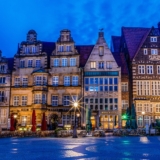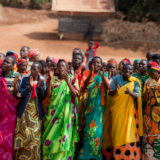There is a place at the edge of Europe, by the Caspian Sea and just before the Ural Mountains where you can find the only Buddhist people with roots in this old continent.
The Kalmyk people
They are the Kalmyks and they have been living there since the XVII-th century, after a long journey from Mongolian Djungaria, a land Far East in Siberia. Like all other people who have undergone such an extensive journey, as they looked for a new home, tried to go back and have been chased around the steppes a few times, Kalmyks have been subjected to contrasting cultural influences and have emerged as quite original themselves.

A Kalmyk girl dressed in the Russian fashion
From their shamanic roots, to the Tibetan Buddhism that dominates them, to the pressure of living under a Russian bureaucracy and surprisingly as the once chess capital of Europe, Kalmyk culture has felt it all.
Kalmykia is the most Eastern of European realms and the most Western of Asian cultures, uniting such strong contrasts in everyday life and reflecting its history even in names.
Kalmyk Names
On the surface Kalmyk names seem quite Russian, with a given name, a patronymic – typical for the Russian fashion, and a family name. However, on a closer look, they reveal sounds that are not easily encountered in the Slavic language, like Sanzh-Ara / Санж-Ара, Tzakhan / Цаhан and Bembe / Бембэ.
They are of pagan origin, following the Mongolian customs and reflecting shamanic beliefs. Like all East Siberians, the Kalmyks remained close to their totemic origins, even after converted to Buddhism, choosing names to reflect their ideals, like Seekha / Сээхэ (beautiful), Erendgen / Эренджен (treasure), Gardya / Гардя (eagle) and Nokha / Ноха (dog).
Even after having left their homeland in Dzungaria, they did not leave the Mongolian connection and their fascination with astronomy. Names like Bembe / Бембэ (Saturn) and Pyurvya / Пюрвя (Jupiter) show that the olden gods of the sky are still asleep beneath a Tibetan outer layer. One might get a Buddhist name like Sanzh / Санж (enlightened) but remain Bayn / Байн (bounty) like their forefathers.

The Golden Temple in Elista, Kalmykia
The given name was very important to all Mongolian people, seeing as they wouldn’t traditionally use family names. A patronymic would make up for it and most of them have become surnames under the Russian rule.
And as Russia likes to view all its subjects as proper citizens, a modern Kalmyk will need to have a given name, a surname – patronymic of origin and an additional patronymic just to fit the bureaucracy. The result of this will be standard by appearance and wonderfully exotic in sound, like the Russian citizen Tzeren – Dorzh Badmaev Kichikov / Церен – Дорж Бадмаев Кичиков and his sister Dunge Badmaeva Kichikova / Дунгэ Бадмаева Кичикова.
Kalmyk language allows you to feminize any name if you please, just don’t expect it to resemble any of the “-a” ending denominations of a Russian lady. Kalmyks find a “-sh” suffix much more sensual, like Kermen – Kermesh (female) meaning squirrel and Perve – Pervesh (female).
Even when, perchance, Kalmyks like a traditional Slavic name and borrow it, they make it their own. Vazki / Вазьки is actually Vasiliy / Василий and Mikula / Микула means Nicholay / Николай.
So from now on, whenever you hear that the Dalai Lama is visiting Europe, know that it’s not just a courtesy visit of ecumenical reasons. He’s simply on a tour to his most western home.
Photo sources:
• Small pavilions in Elista, Kalmykia: by Michael O’Donnabhain
• The Golden Temple in Elista, Kalmykia: by Jialiang Gao
• A Kalmyk girl dressed in the Russian fashion: by Ivan Argunov








